How do I stop House Sparrows?
You can find House Sparrows (Passer domesticus) most places where there are houses (or other buildings), and few places where there aren’t. Along with two other introduced species, the European Starling (Sturnus vulgaris) and the Rock Pigeon (Columba livia), these are some of our most common birds. Their constant presence outside our doors makes them easy to overlook, and their tendency to displace native birds from nest boxes causes some people to resent them. They House Sparrows are very prolific parents and by late summer often dominate feeders of all types in great numbers and prevent the other small birds from accessing the feeders. House Sparrows eat mostly grains and seeds, as well as corn, oats, wheat, sorghum, grass seed, ragweed, buckwheat, millet, milo and insects.
The House Sparrows small size means that it can squeeze through the 1½” spaces on feeder cages and do not close the feeder ports. Unfortunately there are no feeders that are House Sparrow proof; but discouraging them from your feeders is not impossible if you know their weaknesses.
Please note that all of information provided on our website about our products is meant to be informative only. For more information regarding prices and shipping (within Canada only) please visit our store in Newmarket (16655 Yonge Street, Unit #2 Newmarket, ON), phone us (905) 868-9696 or send us an email at [email protected].
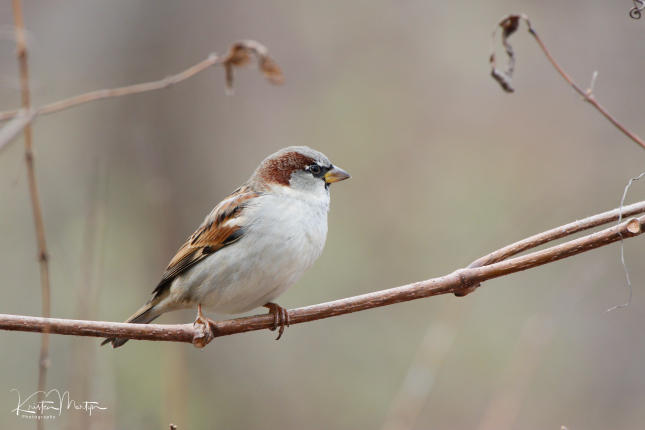
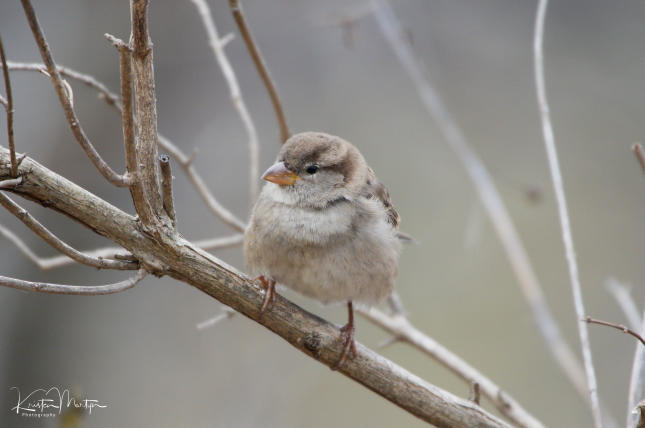
Male, House Sparrows (Passer domesticus) - Left, Photo by Kristen Martyn
Female, House Sparrows (Passer domesticus) - Right, Photo by Kristen Martyn
Here are our 4 Rules for Keeping out House Sparrows
1. Feed Seed Blends Without Millet and Cracked Corn: Many bird seed blends from other stores include “filler” ingredients such as millet, cracked corn, milo, wheat and oats in large quantities. “Filler” ingredients such as wheat and oats are not eaten by any of backyard birds except House Sparrows, Rock Pigeons (or just plain old Pigeons as most people know them) and Mourning Doves. Corn and millet are eaten by some birds but when used in large quantities to fill up a bag of seed to drive the cost down most of it ends up being wasted because feeder birds such as finches and chickadees throw it on the ground in search of sunflower seeds. Seeds dropped on the ground in great quantities can attract House Sparrows. Bottom line good quality blends can help keep House Sparrows away from your bird feeders. None of our WBU Newmarket blends include cracked corn; but we do sell it on its own for feeding jays, doves etc.
Millet is small and an easy seed for House Sparrows to crack with their beak and eat. Millet also generally ends up on the ground. In WBU Newmarket blends we use millet in small amounts with the intention of it being thrown onto the ground for doves, native sparrows and other ground feeding birds. House Sparrows are very comfortable feeding on the ground and millet just encourages them to hang around.
Feeding seed blends with pure edible ingredients such as black oil sunflower seeds, safflower and peanuts will help to discourage birds dumping seeds on the ground for House Sparrows to find. Try these millet and corn free blends in your feeders to discourage House Sparrows:
2. Feed Seeds with Shells: House Sparrows are lazy birds and prefer to eat seeds without shells than to crack open a seed. Feeding a bird seed blend or straight seeds with shells will help to deter House Sparrows from your feeders. While House Sparrows will eat sunflower seeds, safflower seeds and peanuts with shells they prefer to take the easy route and eat sunflower chips, peanuts and other shelled seed. Try feeding these WBU Newmarket Seed Blends, straight seeds and cylinder flavours:
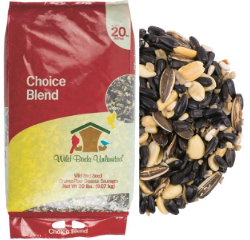 WBU Choice Blend: Our WBU Choice Blend is a fantastic combination of high-oil content seeds. The black oil sunflower, sunflower chips, shelled peanuts, safflower and striped sunflower do a great job of attracting a variety of birds, including chickadees, woodpeckers, titmice, nuthatches and jays. Try offering Choice Blend in a hopper feeder, seed tube feeder or our Dinner Bell™ feeder, and add loads of fun to your backyard bird watching experience.
WBU Choice Blend: Our WBU Choice Blend is a fantastic combination of high-oil content seeds. The black oil sunflower, sunflower chips, shelled peanuts, safflower and striped sunflower do a great job of attracting a variety of birds, including chickadees, woodpeckers, titmice, nuthatches and jays. Try offering Choice Blend in a hopper feeder, seed tube feeder or our Dinner Bell™ feeder, and add loads of fun to your backyard bird watching experience.
Ingredients: Black oil sunflower, sunflower chips, shelled peanuts, safflower and striped sunflower
Bag Sizes: 5 lbs. (2.26 kg), and 20 lbs. (9.07 kg)
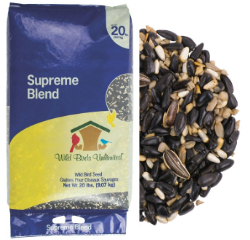 WBU Supreme Blend: WBU Supreme Blend features black oil sunflower, sunflower chips, safflower and striped sunflower in a combination that helps attract a wide variety of birds, such as chickadees, nuthatches, titmice and wrens.
WBU Supreme Blend: WBU Supreme Blend features black oil sunflower, sunflower chips, safflower and striped sunflower in a combination that helps attract a wide variety of birds, such as chickadees, nuthatches, titmice and wrens.
Ingredients: Black oil sunflower, sunflower chips, safflower and striped sunflower
Bag Sizes: 5 lbs. (2.26 kg), and 20 lbs. (9.07 kg)
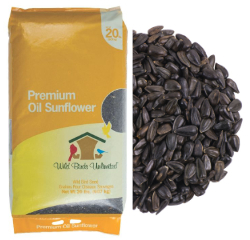 Premium Black Oil Sunflower Seed: Premium Black Oil Sunflower is a favorite of almost all seed-eating birds and the most common ingredient in our blends. Our Premium Black Oil Sunflower is a great source of energy for the birds and 99% free of sticks, stems or other foreign matter so your feeders won't clog with debris. Oil sunflower has a high calorie/ounce ratio due to its high fat and protein content and its relatively thin shell. Among seed ingredients, oil sunflower attracts the greatest variety of small and large seed-eating birds. Studies by the U.S. Fish and Wildlife Service and the Cornell Laboratory of Ornithology have shown that most birds prefer oil sunflower seeds to both striped sunflower and white proso millet. Fill your feeders with this top-grade fuel, and watch the birds flock.
Premium Black Oil Sunflower Seed: Premium Black Oil Sunflower is a favorite of almost all seed-eating birds and the most common ingredient in our blends. Our Premium Black Oil Sunflower is a great source of energy for the birds and 99% free of sticks, stems or other foreign matter so your feeders won't clog with debris. Oil sunflower has a high calorie/ounce ratio due to its high fat and protein content and its relatively thin shell. Among seed ingredients, oil sunflower attracts the greatest variety of small and large seed-eating birds. Studies by the U.S. Fish and Wildlife Service and the Cornell Laboratory of Ornithology have shown that most birds prefer oil sunflower seeds to both striped sunflower and white proso millet. Fill your feeders with this top-grade fuel, and watch the birds flock.
Bag Sizes: 20 lbs. (9.07 kg) and 50 lbs. (22.67 kg)
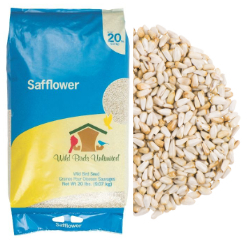 Safflower Seed: Sunflower-eating birds love safflower; squirrels and blackbirds typically don’t. If you are looking to be more exclusive with your bird feeding, Safflower may be the solution for you. Many of your favorite birds will enjoy safflower, yet blackbirds, grackles and squirrels typically don't. Safflower can be offered in hopper, platform or tube feeders, and it is especially helpful for window or deck feeders where blackbirds or squirrels may be a problem. Offer Safflower gradually, mixing it with the seed blends you currently provide, and over time, you'll end up with a dining spot for all kinds of birds, including House Finches, woodpeckers, nuthatches and chickadees.
Safflower Seed: Sunflower-eating birds love safflower; squirrels and blackbirds typically don’t. If you are looking to be more exclusive with your bird feeding, Safflower may be the solution for you. Many of your favorite birds will enjoy safflower, yet blackbirds, grackles and squirrels typically don't. Safflower can be offered in hopper, platform or tube feeders, and it is especially helpful for window or deck feeders where blackbirds or squirrels may be a problem. Offer Safflower gradually, mixing it with the seed blends you currently provide, and over time, you'll end up with a dining spot for all kinds of birds, including House Finches, woodpeckers, nuthatches and chickadees.
Bag Sizes: 5 lbs. (2.26 kg ), 10 lbs. (4.53 kg), and 20 lbs. (9.07 kg)
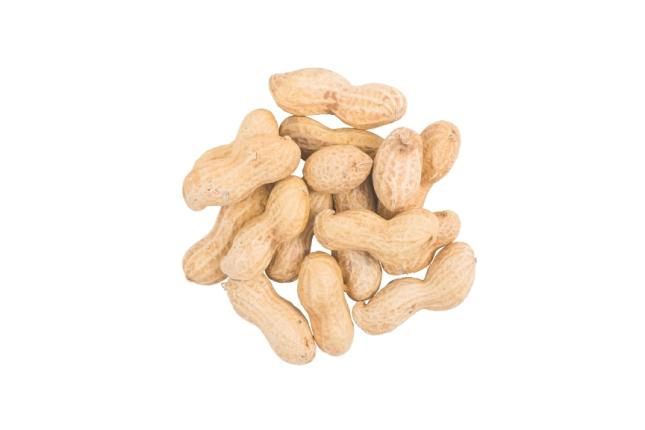 Peanuts in the Shell: Peanuts are the best single source of protein and fat for your birds and a great addition to the choices you offer in your yard. We pride ourselves on being a one-stop bird feeding shop, not only offering bird feeders but also food to fill them. Peanuts in the shell are typically used for feeding squirrels and some of the larger billed birds such as jays. Titmice also enjoy peanuts in the shell. Use our peanuts in the shell in your peanut feeders to provide the energy that birds need.
Peanuts in the Shell: Peanuts are the best single source of protein and fat for your birds and a great addition to the choices you offer in your yard. We pride ourselves on being a one-stop bird feeding shop, not only offering bird feeders but also food to fill them. Peanuts in the shell are typically used for feeding squirrels and some of the larger billed birds such as jays. Titmice also enjoy peanuts in the shell. Use our peanuts in the shell in your peanut feeders to provide the energy that birds need.
Bag Sizes: 3 lbs. (1.36 kg), 6 lbs. (2.72 kg) and 15 lbs. (7 kg)
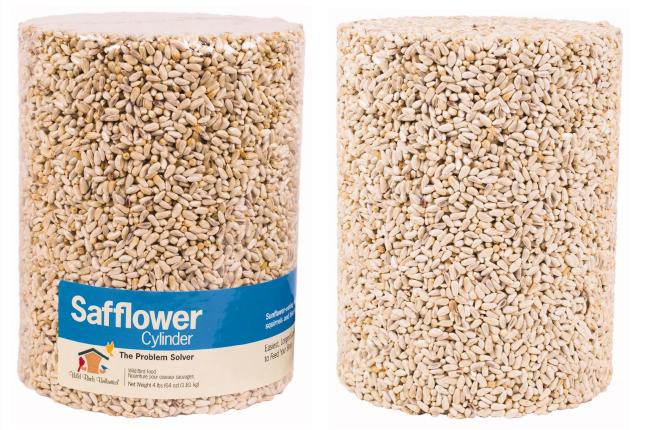 Use Safflower and WBU Safflower Sensation Seed Cylinder: Because of its bitter taste many squirrels do not like safflower, though some will eat it in the worst of weather. Safflower is available as a loose seed to use in most standard feeders or try it in a cylinder feeder with our WBU Safflower Sensation Seed Cylinder. Safflower has high appeal to Northern Cardinals, House Finches, Black-capped Chickadees, Rose-breasted Grosbeaks and Mourning Doves, while being avoided by most squirrels and blackbirds. An added bonus is that squirrels don't care much for safflower either! Approximately 80% of Eastern Gray Squirrels and Red Squirrels do not eat safflower. If offered safflower must be the ONLY seed in a feeder (you can't mix it). So while that may not be 100% squirrel proof, it can be another extremely useful tool in squirrel management.
Use Safflower and WBU Safflower Sensation Seed Cylinder: Because of its bitter taste many squirrels do not like safflower, though some will eat it in the worst of weather. Safflower is available as a loose seed to use in most standard feeders or try it in a cylinder feeder with our WBU Safflower Sensation Seed Cylinder. Safflower has high appeal to Northern Cardinals, House Finches, Black-capped Chickadees, Rose-breasted Grosbeaks and Mourning Doves, while being avoided by most squirrels and blackbirds. An added bonus is that squirrels don't care much for safflower either! Approximately 80% of Eastern Gray Squirrels and Red Squirrels do not eat safflower. If offered safflower must be the ONLY seed in a feeder (you can't mix it). So while that may not be 100% squirrel proof, it can be another extremely useful tool in squirrel management.
Ingredients: Safflower
Cylinder Size: 1.75 lbs. (794 g) and 5 lbs. (2.26 kg)
NOTE: Eastern Chipmunks and Raccoons do eat Safflower.
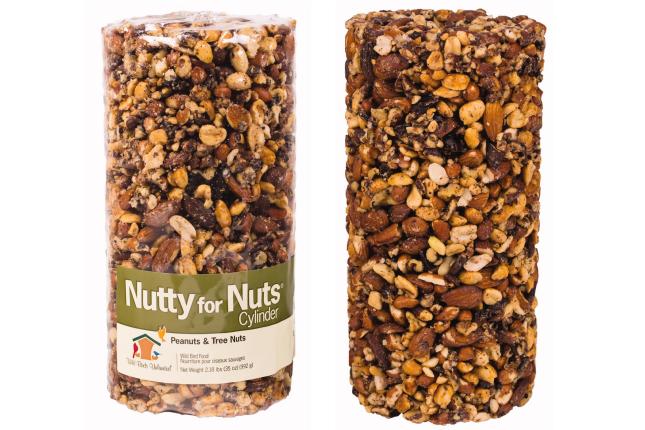 WBU Nutty for Nuts Cylinder: Made of almonds, Brazil nuts, cashews, pecans, walnuts, and roasted peanuts, our Nutty for Nuts™ Cylinder is perfect for attracting nut-eating birds, such as woodpeckers, nuthatches and chickadees, to your yard. Try offering a Nutty for Nuts Cylinder on one of our WBU Seed Cylinder Feeders.
WBU Nutty for Nuts Cylinder: Made of almonds, Brazil nuts, cashews, pecans, walnuts, and roasted peanuts, our Nutty for Nuts™ Cylinder is perfect for attracting nut-eating birds, such as woodpeckers, nuthatches and chickadees, to your yard. Try offering a Nutty for Nuts Cylinder on one of our WBU Seed Cylinder Feeders.
Ingredients: Roasted peanuts, almonds, Brazil nuts, cashews, pecans, walnuts and calcium
Cylinder Size: 2.09 lbs. (949 g)
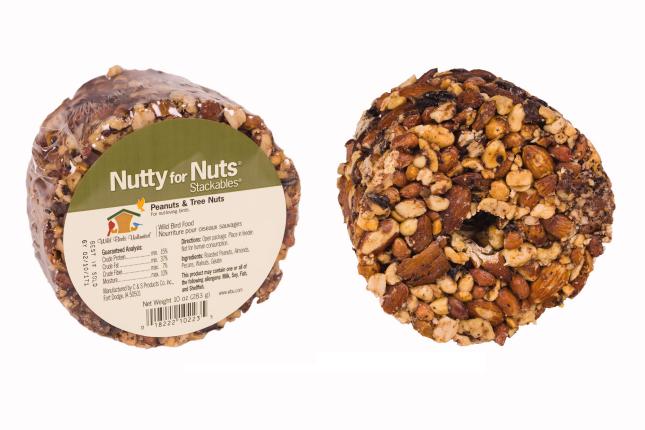 WBU Nutty for Nuts™ Stackables™: Long-lasting and easy to use, Nutty for Nuts™ Stackables™ are a high-protein, high-fat treat loaded with peanuts and large tree nuts, including almonds, walnuts, cashews and Brazil Nuts. Sure to attract nut-loving birds, Nutty for Nuts Stackables™ also contain added calcium to help promote stronger bones. Offer Nutty for Nuts Stackables™ in a WBU Seed Cylinder Feeder.
WBU Nutty for Nuts™ Stackables™: Long-lasting and easy to use, Nutty for Nuts™ Stackables™ are a high-protein, high-fat treat loaded with peanuts and large tree nuts, including almonds, walnuts, cashews and Brazil Nuts. Sure to attract nut-loving birds, Nutty for Nuts Stackables™ also contain added calcium to help promote stronger bones. Offer Nutty for Nuts Stackables™ in a WBU Seed Cylinder Feeder.
Ingredients: Roasted peanuts, almonds, Brazil nuts, cashews, pecans, walnuts and calcium
Cylinder Size: 10 Oz. (283 g)
3. Offer Other Bird Foods that House Sparrows Tend to Avoid: There are some foods that House Sparrows will typically leave along including Nyjer® (thistle), suet, peanuts in the shell, mealworms, BirdBerry Jelly and nectar. Offering these foods can help encourage the backyard birds you want to see while discouraging House Sparrows.
4. Use Feeders that Discourage House Sparrows: House Sparrows prefer feeding on the ground or on feeders that can accommodate both of their feet such as hopper feeders and tray feeders. They will feed from feeders with perches as well, but do prefer a flat feeding space. House Sparrows are not adapted to clinging and feeding so feeders that require birds to cling work the best. Try these feeders to help keep House Sparrows away:
- WBU Finch Feeders
- WBU Hummingbird Feeders
- WBU Oriole Feeders
- WBU Mealworm Feeders
- WBU Suet and Bark Butter Feeders
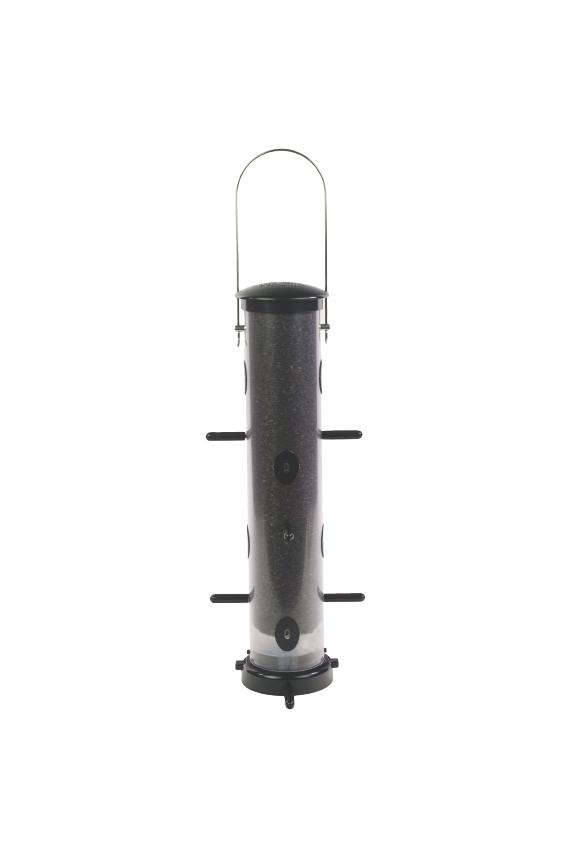 WBU Finch Feeders: WBU EcoClean® and Quick-Clean® Finch Feeders, also called Nyjer® Feeders, are feeders designed specifically for finches and for finch food. Finch Tube Feeders differ from seed tube feeders in that the holes are small enough to accommodate finch beaks, preventing other birds, chipmunks and squirrels from feeding. Our WBU Finch Feeders accommodate Nyjer® seed and our finch blends. Many birds enjoy using WBU Finch Feeders including: American Goldfinches, House Finches, Purple Finches, Indigo Buntings, Pine Siskins, Redpolls and Black-capped Chickadees. The small holes on our WBU EcoClean® and Quick-Clean® Finch Feeders prevent House Sparrows from accessing the food.
WBU Finch Feeders: WBU EcoClean® and Quick-Clean® Finch Feeders, also called Nyjer® Feeders, are feeders designed specifically for finches and for finch food. Finch Tube Feeders differ from seed tube feeders in that the holes are small enough to accommodate finch beaks, preventing other birds, chipmunks and squirrels from feeding. Our WBU Finch Feeders accommodate Nyjer® seed and our finch blends. Many birds enjoy using WBU Finch Feeders including: American Goldfinches, House Finches, Purple Finches, Indigo Buntings, Pine Siskins, Redpolls and Black-capped Chickadees. The small holes on our WBU EcoClean® and Quick-Clean® Finch Feeders prevent House Sparrows from accessing the food.
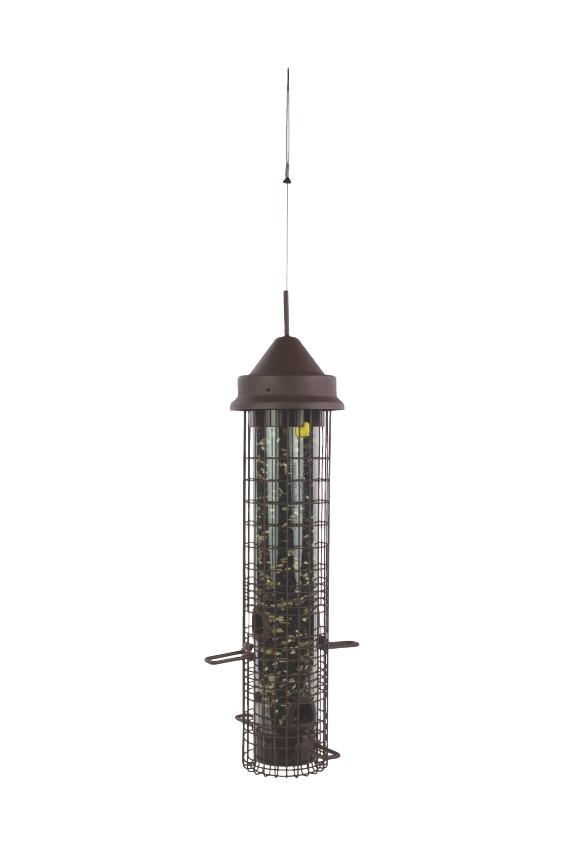 Remove Perches: Keep House Sparrows away by removing the perches from our WBU Fundamentals Squirrel-Proof Bird Feeder. Birds can cling to the metal shroud to feed. The patented Seed Tube Ventilation System™ that keeps seed dry and fresh is also included. It's easy to hang, holds 6 cups of seed (2.5 lbs.) and is backed with a two year hassle-free warranty. The WBU Fundamentals Squirrel-Proof Bird Feeder can be disassembled and assembled with no tools, and all of its parts are top shelf dishwasher safe. This feeder is proudly made by a Canadian company.
Remove Perches: Keep House Sparrows away by removing the perches from our WBU Fundamentals Squirrel-Proof Bird Feeder. Birds can cling to the metal shroud to feed. The patented Seed Tube Ventilation System™ that keeps seed dry and fresh is also included. It's easy to hang, holds 6 cups of seed (2.5 lbs.) and is backed with a two year hassle-free warranty. The WBU Fundamentals Squirrel-Proof Bird Feeder can be disassembled and assembled with no tools, and all of its parts are top shelf dishwasher safe. This feeder is proudly made by a Canadian company.
Dimensions: 33" x 8.5"x 4", Tube: 20" x 4.25" diameter
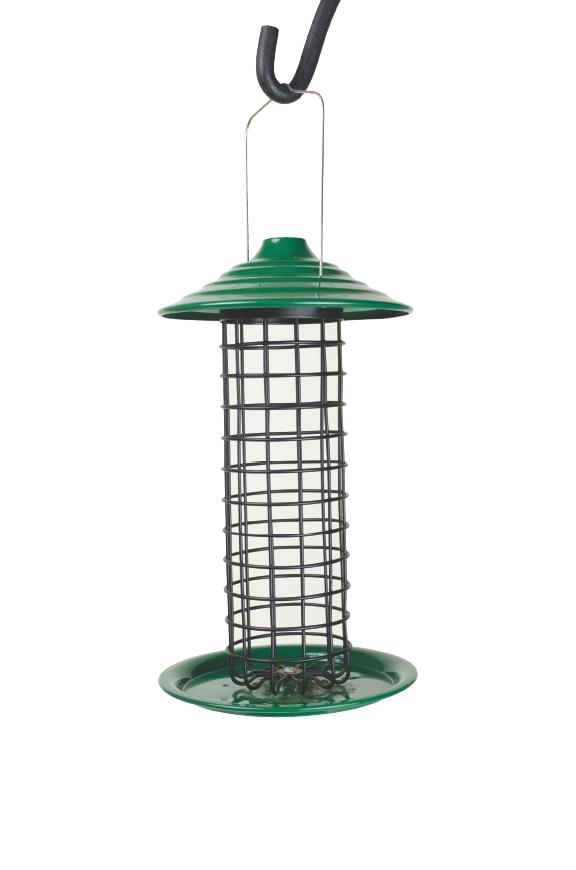 WBU Peanut Hut Bird Feeder: Our WBU Peanut Hut Bird Feeder is the ideal way to offer peanuts in the shell. The large mesh openings are designed to allow the peanuts to be removed easily by peanut-loving birds, including woodpeckers, titmice and jays. The WBU Peanut Hut is easy to fill, and its tray accommodates perching birds and helps keep empty shells from falling to the ground. Peanuts in the shell will help to attract your peanut feeding birds and discourage House Sparrows.
WBU Peanut Hut Bird Feeder: Our WBU Peanut Hut Bird Feeder is the ideal way to offer peanuts in the shell. The large mesh openings are designed to allow the peanuts to be removed easily by peanut-loving birds, including woodpeckers, titmice and jays. The WBU Peanut Hut is easy to fill, and its tray accommodates perching birds and helps keep empty shells from falling to the ground. Peanuts in the shell will help to attract your peanut feeding birds and discourage House Sparrows.
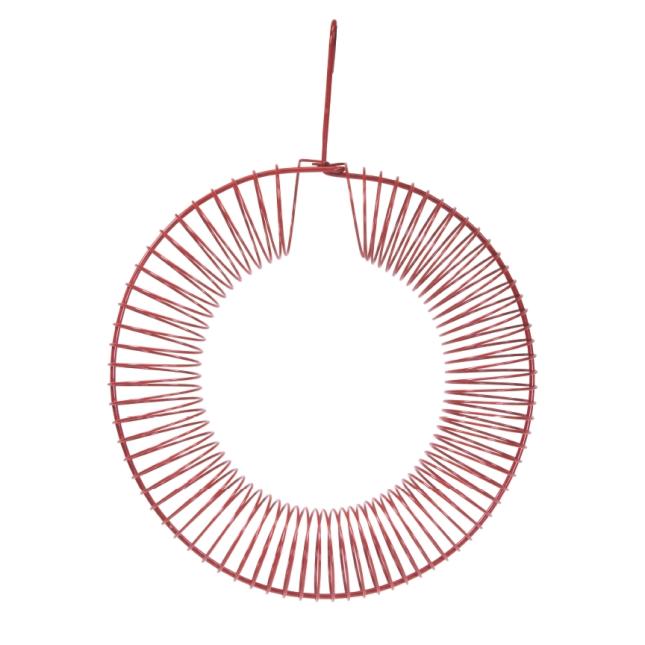 WBU Peanut Wreath Bird Feeder: Enjoy 360 degrees of pure mmmmmm! Hang this WBU Peanut Wreath Bird Feeder in your favorite tree and watch peanut loving birds, such as jays and woodpeckers, fly in for a meal. It's durable, yet it remains flexible so birds can pull out the whole peanuts. Multiple size openings make it possible for a variety of birds to feed. This versatile bird feeder is also great for offering suet balls or nesting material. The WBU Peanut Wreath Bird Feeder is available in both red and green. Peanuts in the shell will help to attract your peanut feeding birds and discourage House Sparrows.
WBU Peanut Wreath Bird Feeder: Enjoy 360 degrees of pure mmmmmm! Hang this WBU Peanut Wreath Bird Feeder in your favorite tree and watch peanut loving birds, such as jays and woodpeckers, fly in for a meal. It's durable, yet it remains flexible so birds can pull out the whole peanuts. Multiple size openings make it possible for a variety of birds to feed. This versatile bird feeder is also great for offering suet balls or nesting material. The WBU Peanut Wreath Bird Feeder is available in both red and green. Peanuts in the shell will help to attract your peanut feeding birds and discourage House Sparrows.


